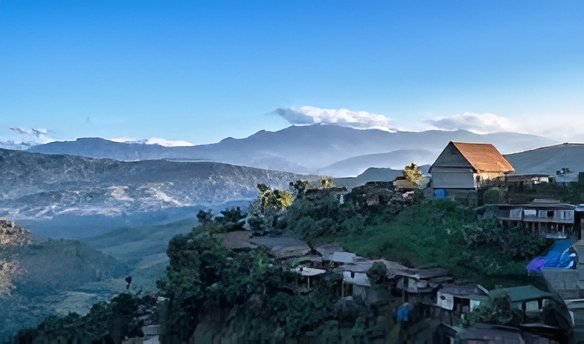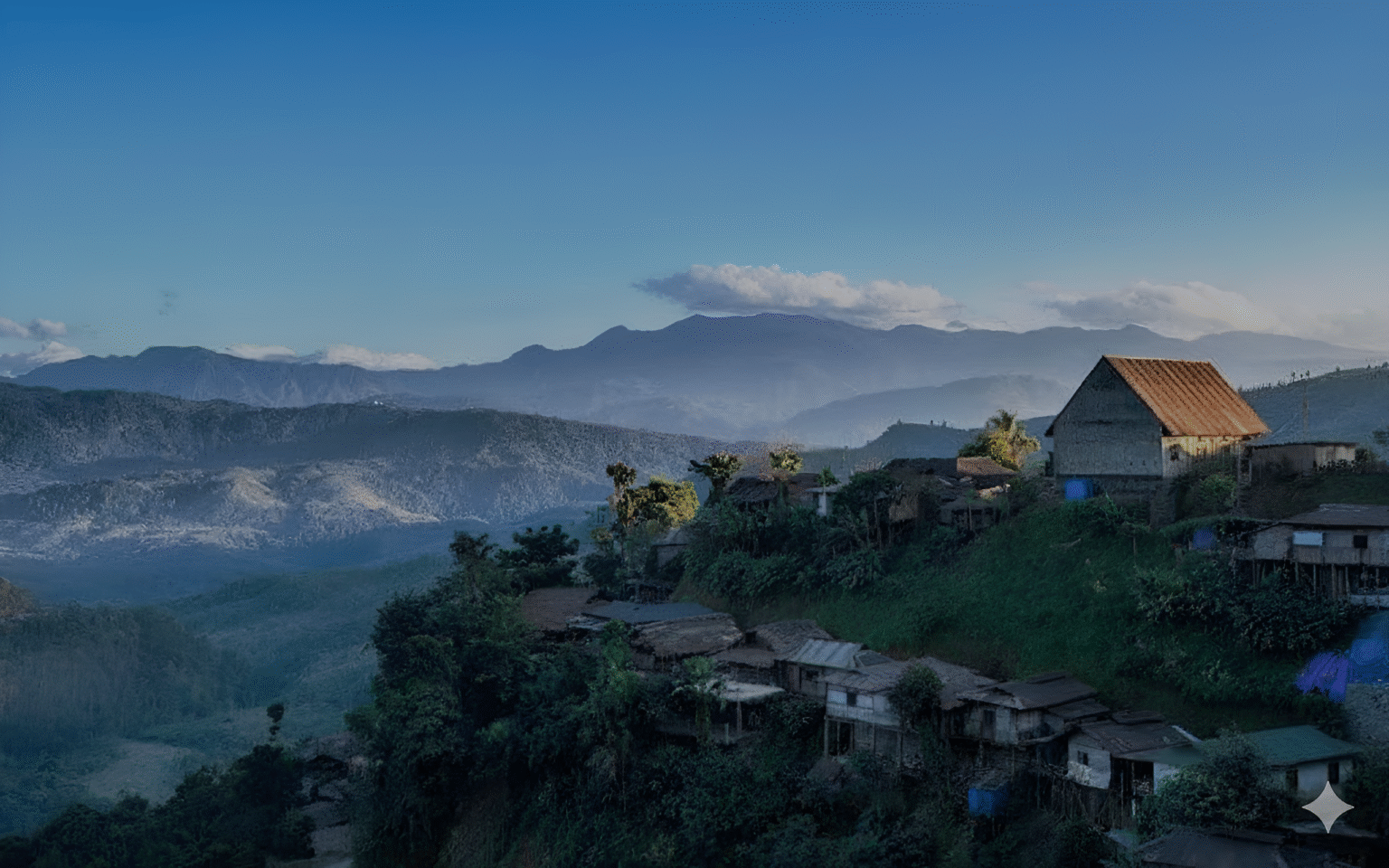Mon Village in Nagaland stands as a living tapestry of tribal heritage, spectacular landscapes, and untold stories stretching back centuries. Located in the northeastern frontier of India, it captivates visitors with its unique traditions, stunning biodiversity, and warm hospitality rooted in Konyak culture.
It is the northernmost district in Nagaland, bordered by Assam, Arunachal Pradesh, and Myanmar. Covering 1,786 sq km, it is the third largest district in the state, featuring rugged highlands, lush valleys, and an altitude of 897 meters above sea level.
- Population: Around 16,590 in Mon Town; 250,260 across the district (2011 census)
- Major Tribe: Konyak Naga
- Literacy: 71% average
- Languages: Konyak, English, Nagamese
Location & List of Places
It district encompasses more than 130 villages and two statutory towns, Mon Town and Naginimora Town.
Notable Villages:
- Shangnyu
- Longwa
- Chi
- Angphang
- Chenloisho
- Tizit
- Monyakshu
- Changlangshu
- Tobu
- Yongkhao
Each holds distinct traditions and regional attractions, making it a mosaic of tribal communities.
Routes: How to Reach Mon Village
It is accessible by road from Assam and Nagaland.
- Via Sonari (Assam): 65 km from Sonari to Mon
- Via Dimapur: Night bus and daytime SUMO services available; approximately 280–357 km
- Via Kohima: Buses connect the capital to Mon
- By Train/Air: No direct rail or flight; nearest airport is Jorhat or Dimapur, with road connections onward through Assam towns
- Chopper Service: Direct weekly helicopter trip from Dimapur
Key Details:
- The ideal window for visiting Mon Village is November to April, particularly for festivals or scenic winter weather.
- Homestay and guesthouse options are affordable, starting from ₹179–₹500 per night.
- Local transport between towns and villages is available with budget Sumo cabs or buses; permits are required for tourists.
- Tour packages vary by season and inclusions, with group/cultural visits costing up to ₹25,000, depending on activities.
History of Mon Village
Originally outside the reach of British civil administration, it was integrated into India’s Northeast Frontier Tract in 1914, but civil policing and governance began only after 1948. In 1951, the district became a part of the North East Frontier Agency and was subsequently carved out from the Tuensang district in 1973.
The Konyaks, Mon’s indigenous tribe, are renowned for their tattoo traditions and the Angh chiefdom system. Eight chief Anghs still lead regional clusters of villages, maintaining ancient customs and robust tribal governance.
Culture: Living Traditions & Festivals
Mon’s Konyak population celebrates identity through elaborate face and body tattoos, vibrant beadwork, and handwoven textiles. The Angh chief’s house, often centuries old, remains a cultural and spiritual focal point.
Major Festivals
- Aolingmonyu: Celebrated in April, marking the sowing season and the Konyak New Year.
- Aonyimo: Held in July-August, a post-harvest gathering.
- Laoun-ongmo: Thanksgiving festival after agricultural completion.
Traditional dances, morungs (youth learning dormitories), black tea hospitality, and crafts like basketry, woodwork, and brass items are integral to its village life.
Tourist Spots: Must-See Places
Shangnyu Village
- Famous for its 500-year-old Angh house and a wooden monument with mystical carvings said to be created by angels.
Longwa Village
- The unique Angh house, straddling the India-Myanmar border, dominates local lore. The chief rules 60 villages across both nations.
Chi Village
Veda Peak
- The highest point in Mon district offers breathtaking views of the Brahmaputra and Chindwin rivers; a nearby waterfall enchants visitors.
Naginimora
Chenloisho
Wildlife & Nature
- Home to Singphan Wildlife Sanctuary (23.57 sq km), rich in rare orchids, medicinal plants, and wildlife like elephants, tigers, hornbills, mithuns, and the elusive tragopan pheasant.
Revenue & Local Economy
It district’s economy revolves around agriculture, cottage industries, coal mining (Naginimora), and handicrafts, especially textiles, basketry, and woodcarving.
- Cottage Industry: Weaving, artisanship, training centres active since the 1970s
- Trade: Bay leaves, coal, handicrafts
- Revenue: State revenue consists of agriculture, local mining, GST, and non-tax receipts, showing gradual growth in recent years.

Culture & Heritage
Its vibrant heritage is anchored by the morung system, seasonal festivals, and colourful traditional attire. Each village showcases artistic skills in wood, bamboo, textiles, and melodious music reflecting centuries of oral tradition.
Biodiversity & Nature
Singphan and other sanctuaries protect regional flora and fauna, while medicinal herbs add economic and cultural value. Lush forests, wild orchids, elephants, tigers, and hornbills offer nature lovers a rare window into northeastern India’s biodiversity.
Recent News
Its local government and traditional leaders have announced new ecotourism schemes focused on sustainable visits, cultural exchange, and skill development for villagers. The annual heritage festival drew thousands in 2025, highlighting Konyak arts, dances, and historic monuments. Increased connectivity, fresh travel options, and conservation efforts are set to make Mon District a new hotspot for responsible travellers exploring northeast India’s hidden gems.
FAQs About Mon Village
What is Mon Village famous for?
It is known for its tattooed Konyak tribe, ancient chiefdoms (Anghs), unique border villages, festivals, and breathtaking scenery.
Which tribe resides in Mon?
The Konyaks are the indigenous tribe, known for their warrior history, distinctive tattoos, and traditional governance system.
What is the best time to visit Mon?
Winter (October–February) is ideal for travel. The weather is pleasant and the landscape stunning; the Aolingmonyu Festival in April is a cultural highlight.
Are there direct flights or trains to Mon?
No. The nearest airports are Jorhat and Dimapur; travel to Mon requires road connections from Assam or Nagaland towns.
What are the must-see attractions?
Shangnyu, Longwa (India-Myanmar border), Veda Peak, Chi, Naginimora, wildlife sanctuaries, and vibrant village festivals top the list.
Is Mon safe for tourists?
It is peaceful and visitors are welcomed warmly. It’s advised to show respect for local customs and contact local guides for deeper village visits.
What souvenirs can travellers buy?
Handwoven textiles, beadwork, wood carvings, and local herbal products make for memorable souvenirs.
How significant are the Anghs in Mon culture?
The Anghs (chiefs) are central; their homes, rituals, and leadership shape daily life and cultural preservation across villages.
